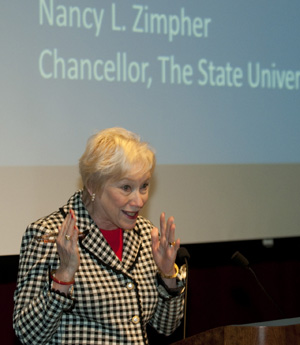Bulletin News

08/23/2012
SUNY Cortland launched its 2012-13 academic year in grand style Thursday morning, with a special visit and remarks from State University of New York Chancellor Nancy L. Zimpher during the College president’s annual opening meeting.
“As you know, there are 64 (SUNY) campus convocations, so this is sort of the representative effort to say: things are back, school is starting and it’s an incredibly exciting time for the State University of New York,” Zimpher said to an audience of College faculty and staff members in the Corey Union Function Room.
Making her third visit to the College since she took the reins as chancellor in 2009, Zimpher spoke for roughly half an hour on SUNY’s long-term vision and SUNY Cortland’s role in what she called “a renaissance for the State University of New York.”
“Even in the brief conversations I’ve had today with four or five faculty members that I’ve had the opportunity to speak to, I could hear and see the ideas, the programs, the leadership that you are providing to make these ideas a reality,” Zimpher said. “It’s one thing to go around saying we are the power of SUNY. It’s another to assert that we can be New York’s future.
“But in the final analysis … you have to turn that into action, into strategy, and I think that’s what we’ve been doing.”
Earlier in the morning, College President Erik J. Bitterbaum recapped an eventful year on the SUNY Cortland campus, which included the hiring of 34 new full-time faculty members.
“We hit the jackpot with these 34 new faculty,” Bitterbaum said. “They’ve added new insights. They’ve added new energy.”
He also described six different construction projects totaling roughly $150 million that are slated for completion over the next three years. They include the renovations of Bowers Hall and the Dowd Fine Arts Center; construction of a new residence hall and the Student Life Center; and upgrades to the Neubig Hall loading dock and the electrical substation housed near the Stadium Complex.
“For my faculty and for my students and staff, we will have world-class facilities for scholarship, for teaching, and I think we deserve it,” Bitterbaum said. “I think that’s the kind of institution we are.”
Zimpher mentioned SUNY’s ability to serve as an engine for New York state’s revitalization, both economically and culturally. Bitterbaum reported SUNY Cortland’s estimated economic impact on Central New York to be $251 million, based on a recent study conducted by Economics Department faculty members. He also reiterated the College’s commitment to Antlers, the outdoor and environmental education center located on the shore of Raquette Lake.
The College’s unique Center for Environmental and Outdoor Education, situated in the Adirondacks, is a precious resource to be shared as much as possible with students, faculty and staff, he said.
“We need to get students to understand about their environment,” Bitterbaum said.
The environment came up again in Zimpher’s discussion of energy-smart New York, one of SUNY’s six big ideas, along with the entrepreneurial century, the seamless education pipeline, a healthier New York, a vibrant community and the world. During his remarks, Bitterbaum hit on all of the priorities and shared an interesting tidbit: the tonnage of carbon dioxide SUNY Cortland produces has decreased to the point where it could power 65 homes year-round in Cortland County.
The importance of education that offers students “hands-on” experience during their undergraduate years came up in Zimpher’s address and later in the morning during a presentation by Richard Kendrick, a professor of sociology/anthropology and director of SUNY Cortland’s Institute for Civic Engagement.
“Where we’re moving is that the State University of New York would be a national leader in experiential education,” Zimpher said.
Kendrick offered many examples of engaging programs at SUNY Cortland, including internships. He mentioned a study released this year by the National Survey of Student Engagement. It reported that, by their senior year, 73 percent of SUNY Cortland students had participated in a form of hands-on learning, whether it was through an internship, clinical assignment or field experience. By comparison, 50 percent of fourth-year students at other surveyed institutions shared a similar hands-on experience.
Internships, along with programs such as study abroad, service learning and undergraduate research, have allowed SUNY Cortland students to turn a traditional education experience into a transformative learning process, Kendrick said.
Zimpher concluded by explaining the need for “systemness” — her word for collaboration among different campuses — to tighten the day-to-day operations of SUNY.
“We have to have a disciplined approach to our work, and we have to reduce costs, we have to increase productivity and we have to give our best efforts to the student experience,” she said. “Every dollar we save, every cost we cut, and every production efficiency we realize is an investment in our students.
“And the more you save, right here at Cortland or with your colleagues in this region, the more you’re going to have to spend on the student experience.”

